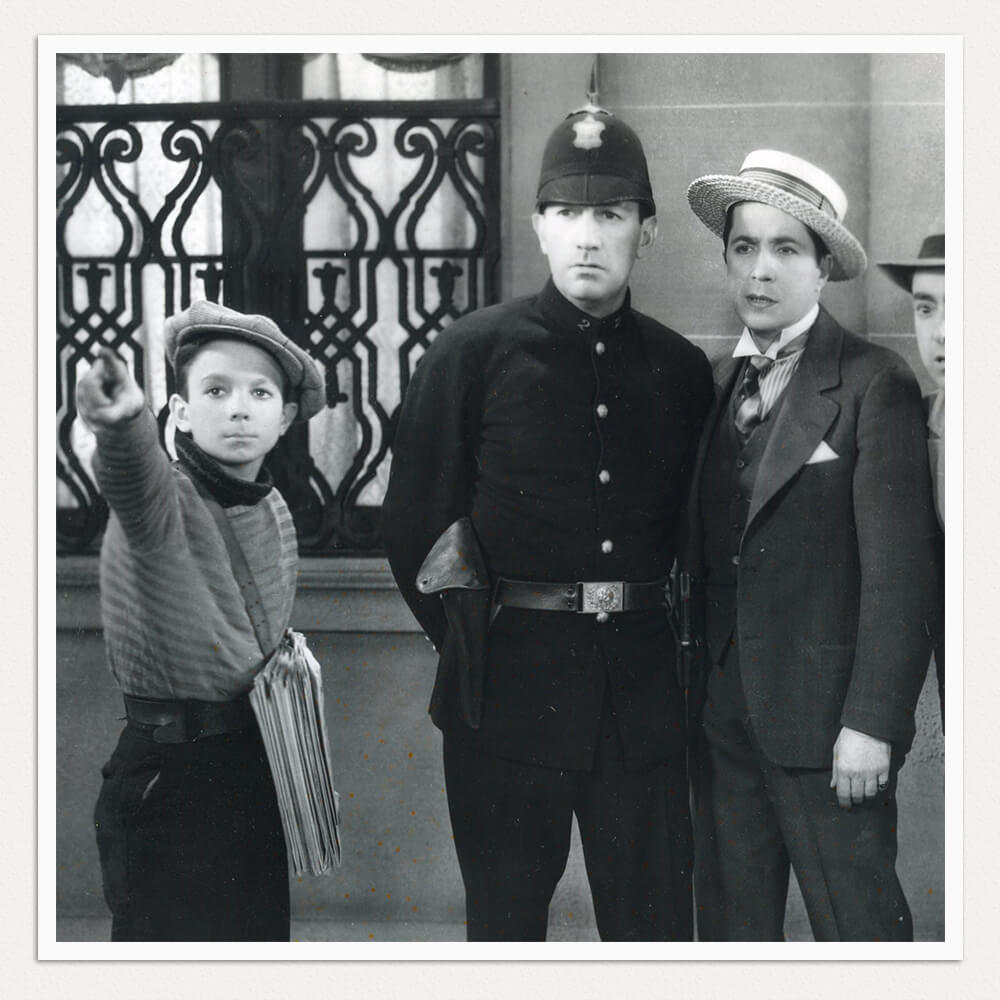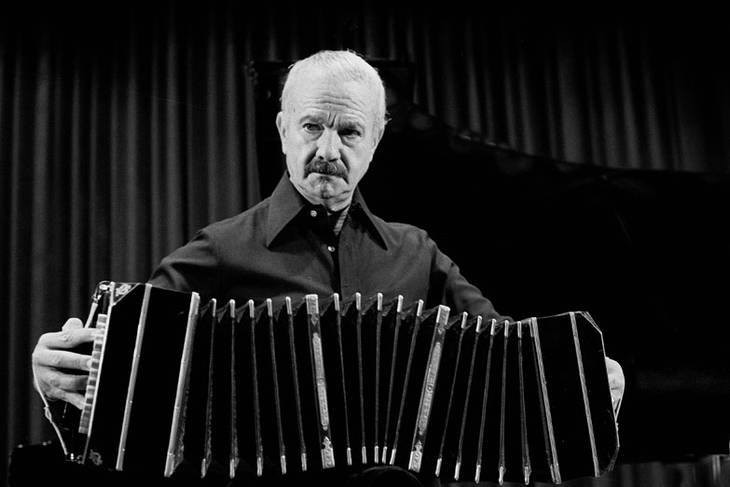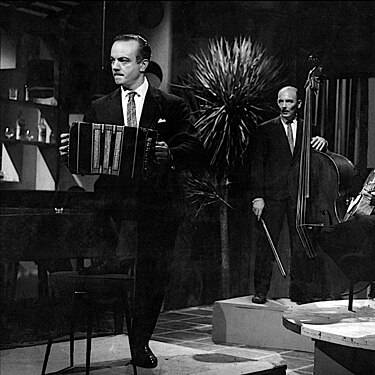



Astor Pantaleón Piazzolla (Mar del Plata, 11 de marzo de 1921 – Buenos Aires, 4 de julio de 1992) fue un bandoneonista, director de orquesta y compositor argentino considerado uno de los músicos más importantes del siglo xx45 y uno de los mayores exponentes de tango en todo el mundo.
Su contacto con la música se inició en Nueva York, donde su familia vivió entre 1925 y 1936. A los ocho años, su padre le regaló su primer bandoneón, y comenzó a tomar clases con Andrés D´Aquila; realizó una grabación en acetato con tan solo diez años, sin fines comerciales. En 1933, estudió música con el pianista húngaro Bela Wilda, quien lo introdujo en el universo sonoro de Bach. Al año siguiente, conoció a Carlos Gardel y, rápidamente, entabló una relación amistosa con él. Gardel lo oyó tocar y le ofreció participar y tocar varios temas en la película El día que me quieras; en la cual interpretó a un canillita. También fue invitado a la gira por América en la que Gardel perdió la vida junto a su equipo; pero, dada su corta edad, no viajó por no tener permiso.
En 1936, su familia volvió a Mar del Plata, y Astor participó en varios conjuntos y conoció la obra del sexteto de Elvino Vardaro, que lo influenció de forma definitiva. Decidido a explorar el tango, se mudó a Buenos Aires a los diecisiete años y, al poco tiempo, consiguió su objetivo: ingresar en la orquesta de Aníbal Troilo, primero como bandoneonista de fila y ocasional pianista y, luego, convertido en arreglador de la orquesta. Continuó sus estudios de música académica con Alberto Ginastera y, de piano, con Raúl Spivak. Sus arreglos lo alejaron cada vez más del tango clásico. Hacia 1944, abandonó la Orquesta de Troilo para dirigir la orquesta que acompañó al cantante Francisco Fiorentino hasta 1946, cuando compuso El desbande, considerado por él mismo su primer tango con una estructura formal diferente. Formó su propia orquesta, que disolvió en 1949, y comenzó a escribir música para películas. Se apartó del bandoneón y se acercó al jazz: la búsqueda de un estilo diferente a todo lo llevó a profundizar sus estudios musicales.
Entre 1950 y 1954, compuso obras claramente distintas de la concepción del tango hasta ese momento (Para lucirse, Tanguango, Prepárense, Contrabajeando, Triunfal, Lo que vendrá), y comenzó a definir su estilo.También en esta época, escribió piezas de música culta, como Rapsodia porteña (1952) y Buenos Aires, tres movimientos sinfónicos (1953). Por la última, ganó el Premio Fabien Sevitzky, y el Gobierno francés le otorgó una beca para estudiar en París con la famosa pedagoga musical Nadia Boulanger, quien lo convenció de que persistiera en el camino del tango: «Astor, sus obras eruditas están bien escritas, pero aquí está el verdadero Piazzolla, no lo abandone nunca». La beca duró casi un año y, en ese tiempo, formó una orquesta de cuerdas junto a los músicos de la Ópera de París Martial Solal y Lalo Schifrin. Con Schirfrin, grabó Two Argentinians in Paris (1955).
A su regreso a la Argentina, convocó a músicos de primera línea y formó el Octeto Buenos Aires. Estaba integrado por Enrique Mario Francini y Hugo Baralis, en violines; Roberto Pansera, en bandoneón; José Bragato, en violonchelo; Aldo Nicolini, en bajo; Horacio Malvicino, en guitarra eléctrica, y Atilio Stampone, en piano. Varias versiones del Octeto influyeron de manera determinante en la futura evolución del tango, debido a sus novedades rítmicas y contrapuntísticas.
En 1984, actuó con la cantante Milva y produjo el disco Live at the Bouffes du Nord; en Viena, grabó Live in Wien con el Quinteto. En 1985, fue nombrado Ciudadano Ilustre de Buenos Aires; y estrenó, en Bélgica, en el Quinto Festival Internacional de Guitarra, el Concierto para Bandoneón y Guitarra: Homenaje a Lieja, con la dirección de Leo Brouwer. En 1986, recibió en París el Premio César por la banda sonora de la película El exilio de Gardel; y grabó en vivo, junto a Gary Burton, Suite for Vibraphone and New Tango Quintet, en el festival de jazz de Montreux (Suiza). En 1987, se presentó con un multitudinario recital en el Central Park (Nueva York). En 1988, grabó con el Quinteto La Camorra su último disco. En 1989, formó Sexteto Nuevo Tango, con el que actuó en el Teatro Ópera, realizó giras y se presentó como solista hasta su disolución a fines de ese año.
El 4 de agosto de 1990, en París, sufrió una trombosis cerebral que lo dejó postrado. Murió el 4 de julio de 1992, en Buenos Aires.
Astor Pantaleón Piazzolla (Mar del Plata, March 11, 1921 – Buenos Aires, July 4, 1992) was an Argentine bandoneon player, conductor and composer considered one of the most important musicians of the 20th century45 and one of the greatest exponents of tango around the world.
His contact with music began in New York, where his family lived between 1925 and 1936. At the age of eight, his father gave him his first bandoneon, and he began taking classes with Andrés D’Aquila; He made a recording on acetate when he was only ten years old, without commercial purposes. In 1933, he studied music with the Hungarian pianist Bela Wilda, who introduced him to the sound universe of Bach. The following year, he met Carlos Gardel and quickly established a friendly relationship with him. Gardel heard him play and offered him to participate and play several songs in the film El día que me siempre; in which he played a little canillita. He was also invited to the tour of America in which Gardel lost his life along with his team; but, given his young age, he did not travel because he did not have permission.
In 1936, his family returned to Mar del Plata, and Astor participated in several groups and learned about the work of Elvino Vardaro’s sextet, which influenced him definitively. Determined to explore tango, he moved to Buenos Aires at the age of seventeen and, shortly after, achieved his goal: joining Aníbal Troilo’s orchestra, first as a bandoneonist and occasional pianist, and then becoming the arranger of the orchestra. orchestra. He continued his studies in academic music with Alberto Ginastera and, in piano, with Raúl Spivak. His arrangements took him further and further away from classic tango. Around 1944, he left the Troilo Orchestra to direct the orchestra that accompanied the singer Francisco Fiorentino until 1946, when he composed El desbande, considered by himself his first tango with a different formal structure. He formed his own orchestra, which he dissolved in 1949, and began writing music for films. He moved away from the bandoneon and approached jazz: the search for a style different from everything led him to deepen his musical studies.
Between 1950 and 1954, he composed works that were clearly different from the conception of tango up to that point (To shine, Tanguango, Prepare, Contrabajeando, Triunfal, What will come), and began to define his style. Also at this time, he wrote pieces of music cultured, such as Rapsodia porteña (1952) and Buenos Aires, three symphonic movements (1953). For the latter, he won the Fabien Sevitzky Prize, and the French Government gave him a scholarship to study in Paris with the famous musical pedagogue Nadia Boulanger, who convinced him to persist on the path of tango: «Astor, your erudite works are well written, but here is the real Piazzolla, never abandon him. The scholarship lasted almost a year and, during that time, he formed a string orchestra with Paris Opera musicians Martial Solal and Lalo Schifrin. With Schirfrin, he recorded Two Argentinians in Paris (1955).
Upon his return to Argentina, he summoned top musicians and formed the Octeto Buenos Aires. It was made up of Enrique Mario Francini and Hugo Baralis, on violins; Roberto Pansera, on bandoneon; José Bragato, on cello; Aldo Nicolini, on bass; Horacio Malvicino, on electric guitar, and Atilio Stampone, on piano. Several versions of the Octet had a decisive influence on the future evolution of tango, due to its rhythmic and contrapuntal innovations.
In 1984, he performed with the singer Milva and produced the album Live at the Bouffes du Nord; in Vienna, he recorded Live in Wien with the Quintet. In 1985, he was named Illustrious Citizen of Buenos Aires; and premiered, in Belgium, at the Fifth International Guitar Festival, the Concerto for Bandoneon and Guitar: Homage to Liege, conducted by Leo Brouwer. In 1986, he received the César Award in Paris for the soundtrack of the film El exilio de Gardel; and recorded live, together with Gary Burton, Suite for Vibraphone and New Tango Quintet, at the Montreux jazz festival (Switzerland). In 1987, he performed with a massive recital in Central Park (New York). In 1988, he recorded his last album with the La Camorra Quintet. In 1989, he formed Sexteto Nuevo Tango, with which he performed at the Teatro Ópera, toured and performed as a soloist until its dissolution at the end of that year.
On August 4, 1990, in Paris, he suffered a cerebral thrombosis that left him prostrate. He died on July 4, 1992, in Buenos Aires.
E-10 km 12
Sant Joan de Labritja
Ibiza 07810
Contacto
info@diegomontero.com
+598 95002 765
Costanera a la Barra s/n
El Tesoro
Maldonado 20001